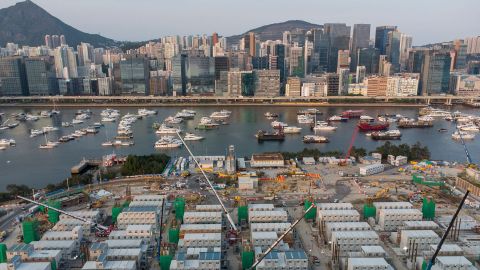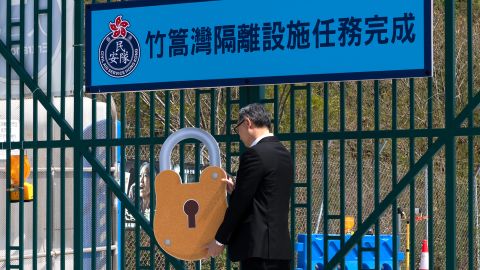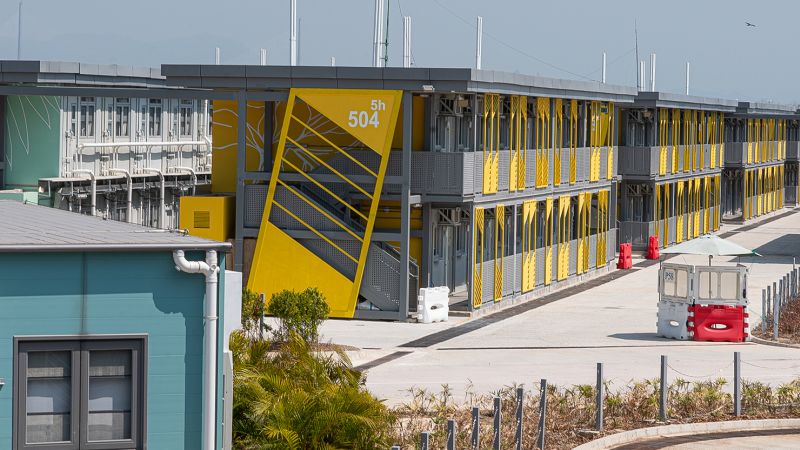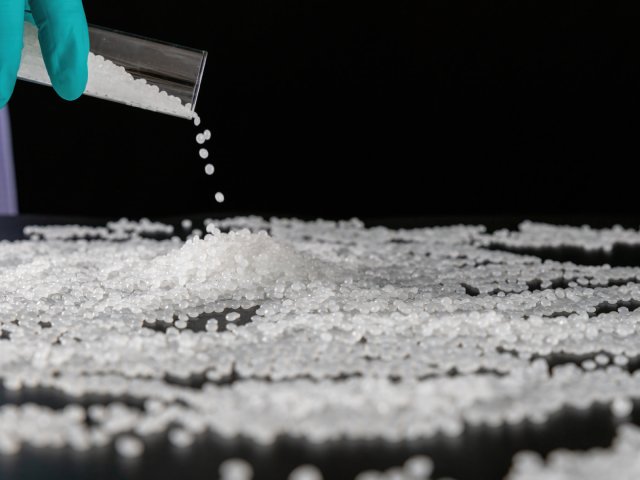Hong Kong
CNN
—
Behind the gleaming skyscrapers and multimillion-dollar homes that have made this city the world’s most expensive property market lies a far less attractive parallel reality: one of the world’s seemingly most intractable housing crises.
Welcome to Hong Kong, where the average home sells for well north of a million dollars – and even a parking space can go for close to a million – but where more than 200,000 people face waits of at least half a decade for subsidized public housing.
Where far below the billionaire’s row of The Peak and its ultra-exclusive properties that routinely change hands for hundreds of millions of dollars, one in five people live below the poverty line – defined in Hong Kong as 50% of the median monthly household income before welfare – and many call home a cramped subdivided unit or even a cage in a dilapidated tenement block.
The cause of the problem, according to the city’s government, is relatively simple: a chronic lack of supply that is unable to meet the demand of more than 7 million residents crammed into what are already some of the world’s most densely populated neighborhoods.
Housing “tops the agenda,” the city’s chief executive John Lee insisted in his maiden policy address in October, as he pledged to build 30,000 units in the next five years – a promise that follows an order by the central government in Beijing to prioritize the issue.
But critics have long been skeptical of the local government’s reliance on land premiums, sales and taxes, which account for roughly 20% of its annual revenues. Critics say this income stream provides an incentive for it to keep supply tight, limiting what can be done to solve the problem.
CNN asked the Hong Kong government whether its revenue from land sales and premiums affects its housing policy. The Development Bureau replied that, “The government is firmly committed to maintaining a steady and sustained land supply through a multi-pronged approach to meet the housing and socio-economic development needs of the community.”
While that debate rages, the abrupt recent unraveling of the city’s harsh anti-Covid measures has thrown a curveball into the mix that – according to those same critics – offers a litmus test as to the government’s determination to solve the problem.
Many are now calling on the authorities to repurpose the vast Covid quarantine camps the city built during the pandemic to isolate hundreds of thousands of people and which currently lie empty and unused.
As Paul Zimmerman, a councilor in Hong Kong’s southern district and co-founder of the urban-planning advocacy group Designing Hong Kong, put it: “Now the question is: what to do with them?”
The answer to that question may be less straightforward than it at first seems.
The camps were one of Hong Kong’s more controversial anti-Covid measures – alongside the world’s longest mask mandate and compulsory hotel isolation periods of up to three weeks – and were opposed at the time of their construction not only among those who decried what they saw as draconian quarantine requirements.
The camps also raised the hackles of government critics who said their speedy and expensive construction gave the lie to the narrative that Hong Kong’s housing problem was simply unsolvable.
Hong Kong authorities have not revealed to the public how much the network of quarantine facilities cost. But its total spending bill on the pandemic in the past three years has run to $76 billion (HK$600 billion), according to the city’s financial secretary. CNN has reached out to the Chief Executive’s office, Security Bureau, Health Bureau and Development Bureau about the costs of building and running these quarantine camps.
Public housing plans are usually subject to years of red tape, but in the case of the quarantine camps the government managed to suddenly “find” around 80 hectares of land and build 40,000 pre-fabricated metal units in a matter of months.
Brian Wong, of the local think tank Liber Research Community, is among those who question why the government can’t take a similarly speedy approach and bypass red tape to solve what it has itself acknowledged is an urgent housing crisis.
Wong and others argue the government’s alleged reliance on land revenue is at risk of turning housing into “a structural problem” that cannot be “meaningfully solved.”
“Even if the government wants to make land affordable, they won’t do that because there’s too much at stake,” said Wong, who is critical of what he sees as official indecision and inaction that he says comes at the expense of the city’s poorest people.
He sees the vacant camps as offering a litmus test of the government’s determination to act and has called for the units to be repurposed into social housing, arguing that it would be “very embarrassed if those containers are left vacant or wasted.”
CNN has asked the Hong Kong government what it plans to do with the former quarantine camps. It said it would announce its plans “after a decision is made.”
Only three out of the eight purpose-built quarantine and isolation camps have actually been used; the remaining five were put on stand-by as vaccination rates rose and infection numbers dipped.
The largest and perhaps most infamous of the camps is Penny’s Bay, a site next to Hong Kong’s Disneyland, where more than 270,000 people stayed in nearly 10,000 units during its 958 days of operation that ended on March 1. A second is located next to the Kai Tak Cruise Terminal and a third near a shipping container port. The rest are dotted along the city’s northern outskirts near the border with mainland China.
Measuring around 200 square feet, each unit is roughly the size of a car parking space and contains a simple toilet, shower and bed. Only some have kitchens.
Still, while the units are spartan, many argue they could still offer an attractive temporary solution for those who cannot afford the city’s high rents. In Hong Kong, according to data compiled by property agency Centaline, even “nano-flats” measuring 215 square feet have recently sold for as much as $445,000 – equivalent to more than $2,000 per square foot.
Francis Law, who was sent to Penny’s Bay in late 2022, said that while simple, the facilities were adequate to meet a person’s basic needs and would offer an attractive temporary option to those on public housing lists.
“If the government rents the units out for around HK$2,000 to HK$3,000 per month [$254 to $382] and arranges a bus route to the nearest train station, I think it would attract a lot of applicants, even if it’s far flung from the main central business district,” he told CNN.
While some of the camps have been built on land owned by local tycoons and loaned to the government, some argue that as the units are modular and relatively easily dismantled they could be moved to more permanent locations – if the government were so inclined.

“We obviously have land in Hong Kong, we have a lot of rural areas…but what we do not have land that is readily available for residential or commercial development,” said Ryan Ip, vice-president and co-head of research at the Our Hong Kong Foundation think tank.
“The key is whether the government actually expedites its procedures.”
Others have more creative suggestions, drawing inspiration from how some of the units were temporarily repurposed during lulls in the pandemic.
At one point, some of the units in Penny’s Bay were used to hold a university entrance exam for secondary school students who were close contacts of infected cases; at another time, the camp hosted a small election polling station.
Hong Kong-based architect Marco Siu is part of a group calling for the blocks at Penny’s Bay to be turned into a temporary health and wellness center, arguing that this would require only a minimal redesign and give authorities the option of reopening it should another outbreak happen.
Zimmerman, of Designing Hong Kong, said the land next to Disneyland could be used to expand the theme park or be repurposed into a new town.

Whether the government will heed any of these suggestions remains to be seen. It has so far been tight-lipped on its intentions.
A spokesperson told CNN that, “Detailed analysis and study will be conducted with relevant government bureaux and departments. Future plans and arrangements will be announced after a decision is made.”
However, a Development Bureau spokesperson added that the units at Penny’s Bay and Kai Tak were “structurally designed for a life cycle of 50 years” and confirmed that they are designed to be “dismantled, transported and reused in other locations.”
In a separate statement, the Development Bureau said the city was committed to a “steady and sustained” supply of land.
“To assume a leading role in land supply, the government has committed itself to a robust land supply strategy to meet demand and build up the land reserve through a multi-pronged approach, including, for example, the development of two strategic growth areas, namely the new supply of over 3,000 hectares of developable land in the Northern Metropolis and the reclamation of 1,000 hectares off Kau Yi Chau (island); and the expedition of the pace of urban renewal.
“As announced in the 2023-24 Budget, in respect of land for private housing alone, we will secure land of a scale which nearly doubles that of the previous five-year period for the production of no less than 72,000 private housing units in the coming five years, and make the land available to the market through the annual Land Sale Programs and railway property developments.”
Still, anyone who watched the closing ceremony for Penny’s Bay earlier this month would have been disappointed if they were hoping for a glimpse into what its future might hold.
As its gates closed, a band played “Auld Lang Syne” and Michael Cheuk, the Undersecretary for Security, placed a giant cut-out padlock on its bars.
“Penny’s Bay quarantine camp has accomplished its mission,” Cheuk told the crowd.
Those same words were plastered on a banner hung across its shuttered gates.








